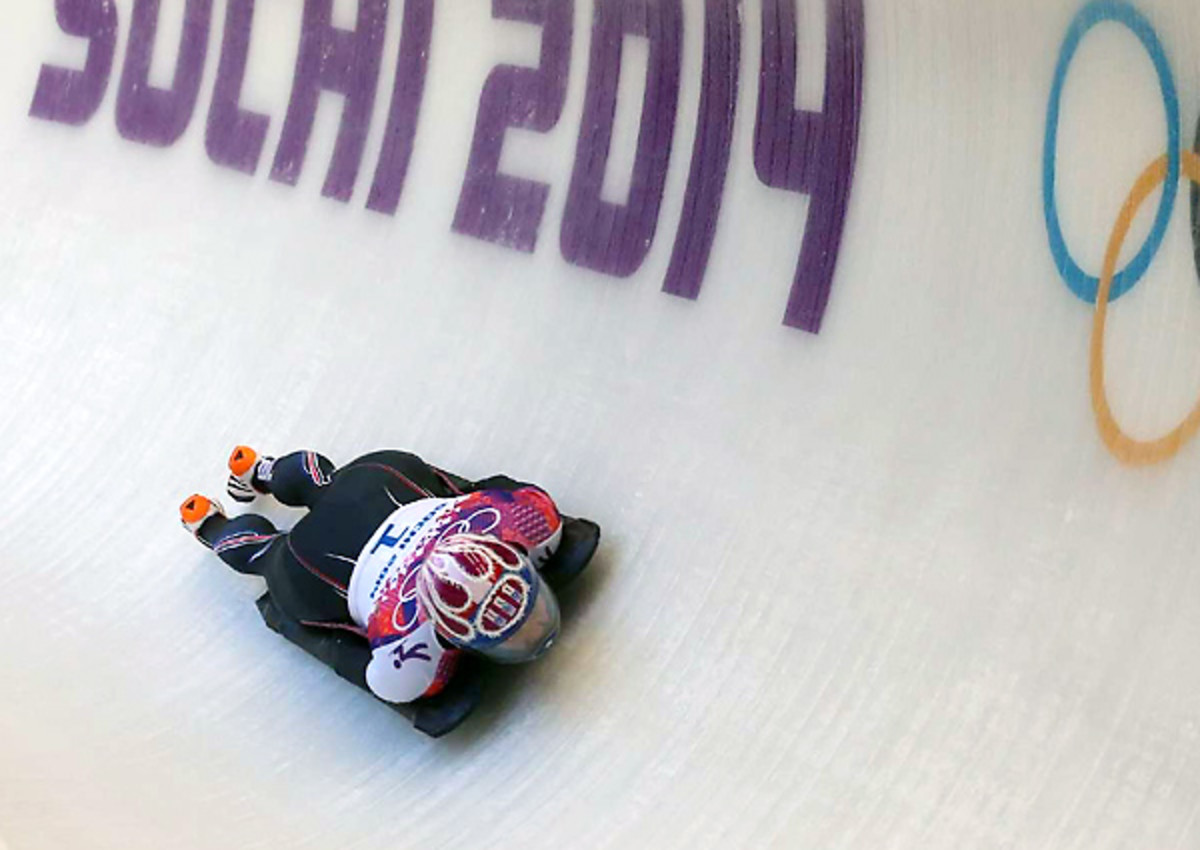Back from retirement, U.S.' Pikus-Pace balances motherhood, skeleton

SOCHI -- She hardly needs them, but every day here provides U.S. skeleton slider Noelle Pikus-Pace with multiple reminders of the unlikely journey that has put her on the cusp of the podium at these Olympics.
It’s the beep that sounds every time she passes through a metal detector at security checkpoints, which the Games provide aplenty. The source of that sound is a titanium rod, implanted in her right leg after a horrific accident.
At a U.S. national team trial event before the 2006 Turin Olympics, in the outrun of a track in Calgary, Pikus-Pace was struck by more than a thousand pounds of runaway bobsled. A bobsled is an SUV in the way a skeleton sled is a bicycle, and the impact sent her skittering 30 feet, shattering that leg in the process.
Somehow, seven weeks later, she mounted a skeleton and placed 20th at a World Cup event in Germany. But her chance of making the games was gone.
A year later she was back, winning the 2007 world championships in St. Moritz by the largest margin ever recorded by a female slider. But at the 2010 Vancouver Olympics, Pikus-Pace placed fourth, missing a medal by a tenth of a second.
She retired, joining her husband, Janson, and their infant daughter, Lacee, at home in Eagle Mountain, Utah.
In 2011 she and Janson had a son, Traycen, and the couple soon found themselves expecting another girl. But in April 2012 she miscarried.
In the trough of the aftermath, at her husband’s urging, Noelle got back on a sled. It felt like the right place to be and led her to return to the circuit -- but only, she and Janson agreed, if the whole family could share the experience.
“It took on a different purpose,” said Amanda Bird, a former teammate. “She was no longer trying to prove herself. She was just trying to enjoy the whole experience with the people she loves.”
To fund four months of travel through Europe during the 2012-13 season, the Pikus-Pace family raised $25,000 from friends and supporters, thanks in part to an online video in which Lacee makes an irresistible appeal to the camera. The sum still left them about $35,000 short of what they needed. Then, just before they were to depart, an anonymous woman handed Pikus-Pace a check for most of the balance.
This season much of the tab has been covered by sponsors like Pampers and Kellogg’s, brands that have kindled to the story of the only mom on the U.S. team who doesn’t carry a curling broom.
Family obligations keep Pikus-Pace the most flexible of flyers. Janson, an engineer who designed her sled, calls himself “Mr. Travel Mom,” and in Sochi he’s overseeing a rented apartment full of extended family -- eight in all; nine if you include Noelle’s sister-in-law’s one on the way. But all the hurly-burly keeps the Olympian in their midst grounded. When she does TV interviews, Pikus-Pace finds it reassuring to hear Traycen crying in the background.

After Thursday’s two heats at the Sanki Sliding Center, she stood second, .44 seconds behind leader and gold-medal favorite Lizzy Yarnold of Great Britain. The final two runs are Friday night, with total time determining spots on the podium.
To be in the medals won’t be easy. The Russian women know their home track “like the back of their hand,” Pikus-Pace said, with one homestanding slider, Elena Nikitina, in third halfway through the competition, .55 seconds back, and two other Russians in the top six.
Meanwhile U.S. teammate Katie Uhlaender sits fourth, .69 seconds adrift. The daughter of late major-leaguer Ted Uhlaender, she wears the NLCS championship ring he won with the 1972 Cincinnati Reds on a chain around her neck. She only removed the baseball card of him that she usually tapes to her sled because Olympic rules forbid it.
This week another couple of potential curveballs came Pikus-Pace’s way. One was a psychological one, a more vivid reminder of her 2005 accident than beeping metal detectors. A track worker was struck by a forerunning bobsled just prior to an afternoon training session. Pikus-Pace had already left the sliding center. According to IOC president Thomas Bach, the worker suffered two broken legs and a possible concussion.
Pikus-Pace seems to have successfully managed the other challenge. She suffers from three herniated disks, the result of a sit-up she did while getting back into shape after her son’s birth. Sure enough, her back acted up during a training run on Wednesday, so she decided to pass up her last two chances to test the track.
That may explain why her first run today was a ragged one. “There’s not much I can do about it except stay off my feet,” Pikus-Pace said, as two huge teardrop earrings bracketed a face adorned with a USA tattoo on one cheek. “Quite honestly, I didn’t know how this day would go. [After the first run] I came right back up and watched the video, and it seemed to help in the second run.”
She may not have anything to prove, but for that very reason a medal would be the sweetest of keepsakes -- like a souvenir from a family trip. “To have been fourth in Vancouver, it weighs on your mind when you do motivational speeches,” she said. “People want to know, ‘Oh, where’s your medal?’ After missing by one-tenth of a second, I’d be stoked just to be on the podium tomorrow.”
ROSENBERG: U.S.' Christensen honors late father's dedication with slopestyle skiing gold
